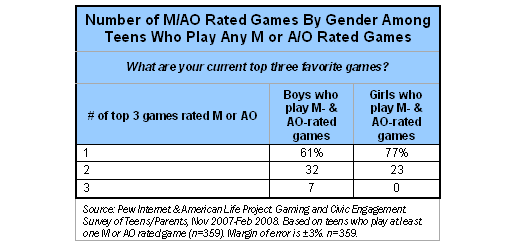Introduction
Beyond a general sense of who plays games, it is important to understand how games are played—what types of hardware and software are used and in what type of social, solitary, or academic settings games are played. Each gaming device offers a variety of opportunities for game play. Different games, sometimes with different ratings for the same game, are offered on various brands and platforms. And different games provide players with a number of ways in which to play with other people, either through dual controllers, Bluetooth links, or connections forged over the internet.
What devices do teens use to play games?
There are a variety of devices and modes of game play. Games may be played on personal computers, on dedicated gaming consoles attached to a television (many of which now have as much processing power as a desktop machine), on cell phones, or on dedicated handheld gaming devices like the PSP or the Nintendo DS systems. Why does this matter? Different games are available on different devices, and more importantly for regulators and parents, different ratings apply to games played in certain environments. Ratings apply to console, dedicated handheld gaming devices, and most computer-based games but are often not given to web-based games, MMOGs, or games played on cell phones. Also, depending on the age of the device a gamer uses, some gaming platforms can connect to the internet.
Consoles are the most common way to play games.
The largest group of teens—86%—plays games on a console, devices such as the Xbox, PlayStation, and Wii. Boys and younger teens are much more likely to play games on a console: 96% of boys have ever played games on a game console, compared with 76% of girls. Younger teens are also more likely to use a game console to play games, with nearly nine in ten (89%) teens ages 12-14 playing games on a console, compared with 83% of older teens.
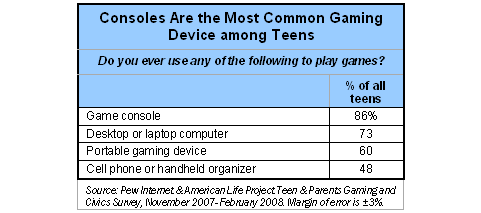
Among older teens, 94% of older boys play games on a console, compared with 71% of older girls. Among younger teens, 97% of boys ages 12-14 play games on a console, compared with 81% of girls the same age. Owning a console is not a prerequisite for playing games with one, as many teens use consoles at friends’ and relatives’ houses—87% of teens who play games on a console own one; 13% of console gamers do not own a console.43 Console ownership does not necessarily match with computer ownership, either. A bit less than one in ten (7%) teens who play games on consoles do not have a computer at home, and another 4% have a computer at home that is not connected to the internet.
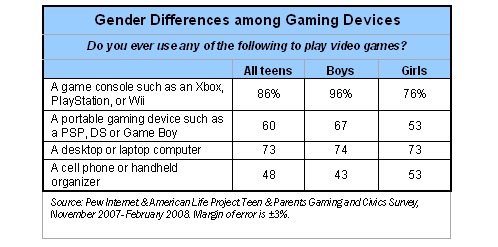
Personal computers are used equally by all groups for game play.
The next most popular vehicle for game play is the personal computer. Nearly three-quarters (73%) of teens play games on a laptop or desktop computer. Computers are also the most broadly used gaming device; in contrast to use of consoles and handheld gaming devices, there is no gender or age variation in game play on a computer—girls and boys, younger and older teens are all equally likely to play games using a desktop or laptop computer. Fully 85% of teens who own a desktop or laptop computer say they play games on it.
Younger teens are the most likely to play on portable gaming devices.
As portable gaming devices grow more sophisticated and cell phone ownership percolates through the teen population, gaming is increasingly going mobile. Portable gaming devices are predominantly the province of the younger set. Six in ten (60%) teens play games on a portable gaming device like a PSP, DS, or Game Boy. Younger teens are much more likely than older teens to play games on a portable gaming device, with younger boys leading the pack. Overall, more than seven in ten (71%) teens ages 12-14 play games on a portable device, compared with just under half (49%) of teens ages 15-17. Boys are also more likely to play games on a portable device, with 67% of boys and 53% of girls reporting such behavior. Younger boys are particularly enthusiastic users of portable gaming devices, with 77% of boys ages 12-14 reporting using a PSP, DS, or other portable device, compared with 65% of younger girls.
Girls and black and lower-income teens are more likely to use cell phones to play games.
The other types of technologies facilitating mobile gaming are cell phones, handheld organizers (PDAs), and other portable devices not purpose-built for gaming. Just about half of teens (48%) say they have played games on a cell phone or PDA,%%FOOTNOTE%% and in contrast to consoles and portable gaming devices, girls are more likely to report gaming on a cell phone than boys. Girls are more likely than boys to play games on these devices—53% of girls play games on cell phones, compared with 43% of boys. Age is not a factor in whether a given teen plays games on cell phones. Cell phone ownership is not a requirement for playing games with them, as 21% of teens who play games on cell phones do not have one of their own. Girls and boys are equally likely to own a cell phone.
There is no difference in the devices a teen uses to play games by race/ethnicity or socioeconomic status, with the exception of cell phone games. Black teens and lower-income teens are more likely than Hispanic, white, or higher-income teens (families earning $30,000 or more per year) to say they play games on cell phones. Notably, there are no statistically significant differences in cell phone ownership by race or ethnicity. However, teens from families earning more than $75,000 annually are more likely to own a cell phone (79% vs. 63%) than teens from families earning less than $50,000 a year.
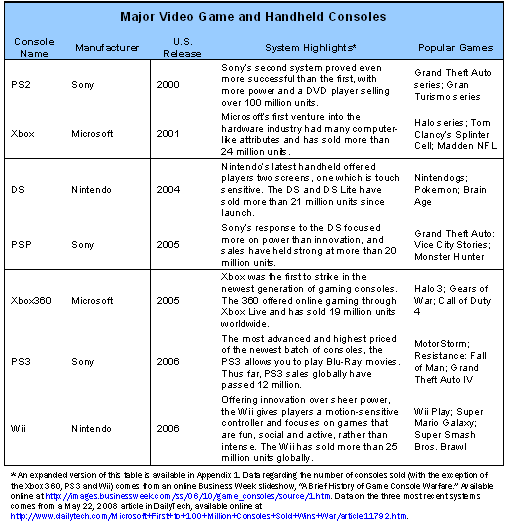
Most teens own multiple gaming devices.
Games today can be played through a number of platforms—consoles, portable devices, computers, and cell phones—and teen ownership of these devices is increasing. While it is important to note that ownership does not equal use, ownership rates are still worth discussing. Of the four gaming devices referenced, six in ten (60%) teens own three or four devices, while just 14% own zero or one device. Furthermore, daily gamers are more likely to own all four devices when compared with non-daily gamers (34% vs. 23%).
All of the gaming devices mentioned in our survey—computers, consoles, handheld gaming devices, and cell phones—can be connected to the internet, and more than three-quarters (76%) of teens connect them and play games online. Teens are equally likely to play online games, regardless of the devices they own. Younger teens are more likely to play games online, regardless of platform. Eight in ten (80%) teens ages 12-14 play games online, compared with 72% of older teens. Boys are also slightly more likely to play games online than girls, with 79% of boys gaming online, compared with 73% of girls. The low number of girls is mostly a factor of the lower levels of online game play among older girls, with 66% of them playing online, compared with 80% of girls ages 12-14. Race and income are not factors in online game play.
Teens play many different types of games.
Today’s gaming marketplace teems with different kinds of games. Trying to bring order to the gaming space by classifying games into genres is a tricky business. Lack of consistency within the gaming industry and among academics who study gaming complicates a game design space that increasingly focuses on games that cross genres or do not fit neatly into any existing category. To devise our genre list, we consulted with industry and academic experts and harmonized their responses into one master list of 14 genres. Because of the ambiguity and lack of consistency in genre labeling of games, genre data here tells us more about how gamers think of themselves in the context of games than exactly which games they play.

As the data suggest, many teens play a wide variety of genres, though differences exist in the likelihood of various demographic groups playing a particular type of game.
Most teens play a variety of different game genres.
Most teens do not limit themselves to just a few game genres, instead choosing to play many different types of games. Fully 80% of teens play five or more different game genres, and 40% play eight or more types of games. Daily gamers are more likely to play a wider range of game genres than non-daily gamers: while 55% of daily gamers play eight or more types of games, just 33% of non-daily gamers do so.
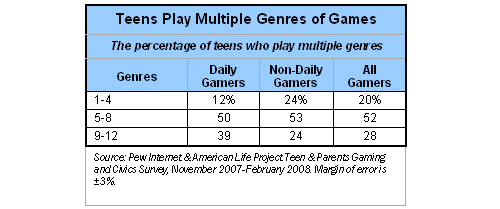
There are differences by race/ethnicity in the types of games played.
Among gaming teens, there are some differences by race or ethnicity in the types of games played. Black teens are more likely to report playing racing games than white or Hispanic teens and are more likely to play sports and adventure games than white teens (though not Hispanic youth). Black and Hispanic teens are more likely than white teens to play fighting games and survival horror games. White and Hispanic teens are more likely to play rhythm games than black teens. White youth are more likely to play MMOGs than black teens (but not Hispanic teens).
Lower-income teens more likely to play certain game genres.
Lower-income teens from families earning under $50,000 per year are more likely than higher-income teens to play racing games (80% vs. 70%), adventure games (72% vs. 63%), or survival horror games (40% vs. 28%).
Boys are more likely to play most game genres.
Boys are more likely than girls to be intensive gamers—playing on a daily basis for a relatively long duration—and are also more likely than girls to play a wider variety of genres. Girls and boys are equally likely to play racing games (77% of boys and 71% of girls), rhythm games (58% of boys and 64% of girls), simulation games (46% boys vs. 52% girls play them), and virtual worlds (11% of boys and 10% of girls). Girls are more likely to report playing puzzle games than boys—with 87% of girls playing them, compared with 58% of boys. However, boys are more likely to play all other game types.
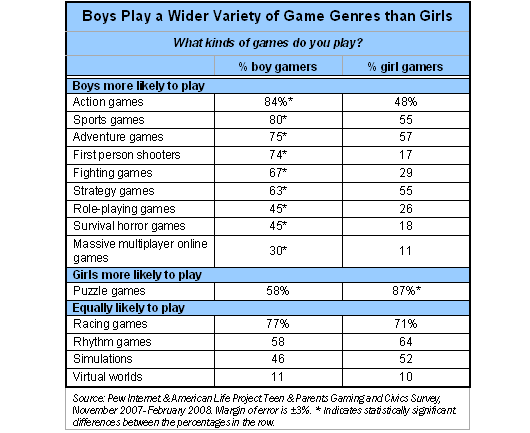
Girls play a narrower variety of games than boys do. Girls report playing an average of just under six game genres, while boys average eight genres of games played. The difference in the percentages of girls and boys who play certain games varies by genre. Sports, adventure, strategy, and role-playing games have relatively smaller gender differences around game play. Genres like first-person shooters, fighting games, survival horror games, and action games show much larger differences between the percentage of boys and girls who play them.
Younger teens are also more likely than older teens to play certain kinds of games. Teens ages 12-14 are more likely than their older counterparts to play sports games (72% vs. 64%) and adventure games (71% vs. 61%).
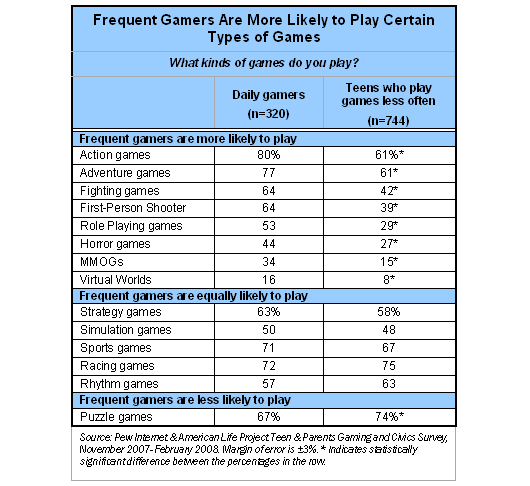
Frequent gamers play a similar range of game genres as boys.
As with differences observed between boys and girls, those teens who play video games daily are more likely to play most game genres, and these frequent gamers’ most popular genres are—for the most part—similar to those of boys’ most popular genres. Daily gamers are more likely than less-frequent gamers to play action, adventure, fighting, first-person shooter, role-playing, and horror games, as well as MMOGs. However, daily and less-frequent gamers are equally likely to play sports and strategy games, whereas boys are more likely to play these genres than girls. Furthermore, daily gamers are more likely to participate in virtual worlds, whereas no differences exist across gender.
Younger teens are more likely to leap into virtual worlds.
Virtual worlds are persistent online play spaces which allow the users to determine the direction of game play. Overall, 10% of all American teens visit virtual worlds—places like Second Life, Club Penguin, and Whyville. There are no gender, racial, or ethnic differences in who visits virtual worlds. However, younger teens are more likely to have visited virtual worlds than older teens, with 13% of 12- to 14-year-olds visiting them, compared to just 8% of teens ages 15-17. Teens who play games daily are also more likely to visit virtual worlds (16%) than teens who play games weekly or less often (8%).
What are massive multiplayer online games?
Massive multiplayer online games (MMOGs)—also sometimes called massive(ly) multiplayer online role-playing games—are online game spaces where multiple individuals can play a game together. While gamers can go anywhere within the digital world of an MMOG, the game developer has determined the direction and goals of game play. MMOGs may be played solo but are often played in groups of individuals who band together to form a “guild” to take on a task, goal, or quest together. MMOGs are also persistent spaces where game play continues to move forward even when an individual or group of players is not playing the game.
Three in ten gaming boys play MMOGs.
One in five (21%) teens who play video games play MMOGs. Boys are much more likely to play MMOGs than girls. Nearly one-third (30%) of boys who game have played a MMOG, compared with 11% of gaming girls. There are no statistically significant differences in MMOG play by age; younger teens and older teens are just as likely to report playing them.
Gamers who play MMOGs are more likely to play games on a daily basis and more likely to play for longer periods of time. Just 45% of gamers who do not play MMOGs say they played any games “yesterday,” while 70% of MMOG players played some form of video game the previous day. While equal percentages of players from MMOG and non-MMOG groups say they played for about an hour “yesterday” (26% of MMOG players and 23% of those who do not play them), more than one in five MMOG players played for two hours “yesterday,” compared with just 11% of other players. Fully 11% of MMOG players reported playing for three hours “yesterday,” compared with 5% of non-MMOG gamers. Overall, 23% of MMOG players played for three hours or more “yesterday,” compared to 10% of those who do not play MMOGs.
The most popular game titles and franchises
What are the most popular game titles?
In this survey, we asked teens about game genres they like to play, as well as their current top three favorite games,44 in order to have multiple dimensions on which to map out the kinds of games teens are playing today. Of the 647 games mentioned in the survey (representing 2618 total responses from participants), 510 are rated games, 78 are unrated online cell phone or computer games, and 59 are unidentifiable.45 There are 33 mentions of game genres, where teens gave a general category of games such as sports or racing games, rather than naming a specific title. Most of the ten most frequently mentioned games in the survey can be classified into multiple genres—rhythm, sports, puzzles, and simulation, to name a few. These top games also show that there are many popular video games that are not simply violent first-person shooters.
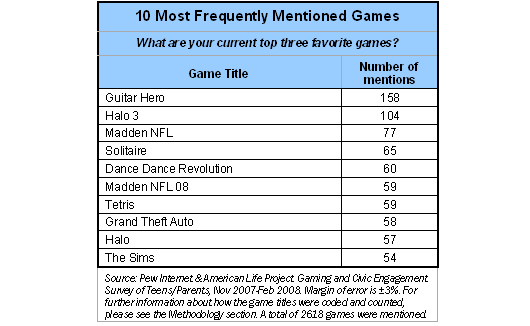
After noticing that two game franchises46 appeared on the top games list twice (Halo and Madden), we also reviewed the five most popular game franchises.
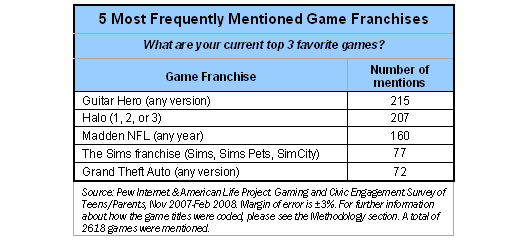
Profiles of top game franchises
Guitar Hero
The Guitar Hero franchise, currently comprising six games, enables players to live out their rock star dreams of playing in their favorite band. Players use a guitar with five buttons for the notes; the goal of the game is to play along with the song by hitting the correct note sequence provided during the song. Originally available only for the PlayStation 2, the game can now be played on PlayStation 3, Xbox 360, Wii, and Nintendo DS.
Teens from affluent households are more likely to report playing Guitar Hero than their less-well-off peers. Almost one-quarter (24%) of teens in households that earn $50,000 or more per year play Guitar Hero, compared with 14% of teens in households that earn less than $50,000. Neither gender nor frequency of game play has any impact on whether a teen plays the game.
Halo
In the third installation of this tremendously popular science fiction series, players continue their journey through a futuristic world in the ultimate battle to save mankind. A first-person shooter, the game allows for solo and multiplayer game play and can be played on the Xbox/Xbox 360 or on a PC. Halo 3 was one of the most anticipated games of 2007 and sold 3.3 million copies in its first 12 days on sale in the U.S.47 Time awarded it “Game of the Year” for 2007.
Boys are overwhelmingly more likely to play a game in the Halo series than girls. Fully 30% of boys play Halo, compared with 5% of girls. Household income, parent education levels, and age do not affect the likelihood of a teen playing one of the Halo games. However, daily and weekly video game players are more likely to play this game than teens who play games less frequently.
Madden
One of the longest-running series of games in history, the Madden NFL games can be found on nearly every game platform available. In the games, players choose from among current NFL football teams and play opponents, choosing the types of offensive and defensive plays their team makes. Teams are comprised of real NFL players and reflect trades and acquisitions in each new season. Newer incarnations of the game allow for multiplayer games, quick games, full seasons, or multiple seasons of play.
Boys are the primary players of the Madden franchise of games. Fully 28% of boys in the survey say they play Madden, compared with just 2% of girls. Age and income do not impact whether a teen will play Madden, but frequent game players are more likely to play Madden than less-frequent gamers: one-fifth (21%) of daily gamers play Madden, compared with 16% of weekly gamers and 9% of teens who game less frequently.
The Sims
The best-selling PC game in history, with more than 100 million units sold,48 The Sims franchise is a series of simulation games that allows players to create characters and worlds and control those characters’ actions as they move around that world. Players can also purchase numerous expansion packs that include new characters, objects, and locations. While the game has been adapted for play on several consoles, the PC version remains the most popular.
Unlike Halo and Madden, girls are more likely to play The Sims than boys. Fully 15% of girls play the Sims, compared with 1% of boys. As with Halo and Madden, age and income do not play a part in determining whether a teen will play the Sims.
Grand Theft Auto
Surrounded by controversy over its gratuitous violence and adult content, the Grand Theft Auto (GTA) series remains one of the most popular games in history. Players lead their character around the fictional Liberty City and attempt to rise through the ranks of the criminal underworld. The series’ most recent release, GTA IV, sold six million copies during its first week of release in April 2008.49 Several of the games are available on both the Xbox and PlayStation consoles, and Nintendo announced in July 2008 that it would release a version of the game on its DS system.50 However, this survey was administered prior to the release of the newest Grand Theft Auto.
Boys and girls are equally likely to play GTA, but older teens (ages 15-17) are marginally more likely to play GTA than younger teens (ages 12-14).
The average rating for teens’ favorite games is just above a Teen rating. Nearly one-third of young teens play M- or AO-rated games.
In addition to identifying how frequently each game title was mentioned, we also looked at how these games are rated by the Entertainment Software Ratings Board (ESRB), the organization that assigns ratings to video games that states how old an individual must be to buy certain games. The ratings range from EC (every child) to AO (adult only).51
The average game rating for the survey (for those games that are rated) is 2.08, an E10+ rating. However, the average game rating for the top ten games is 2.32, which is between E10+ and T. The mean “average game rating” per respondent for their three favorite games is 3.199—which is a bit more than the T rating and indicates games that are appropriate for teens ages 13 and above.52
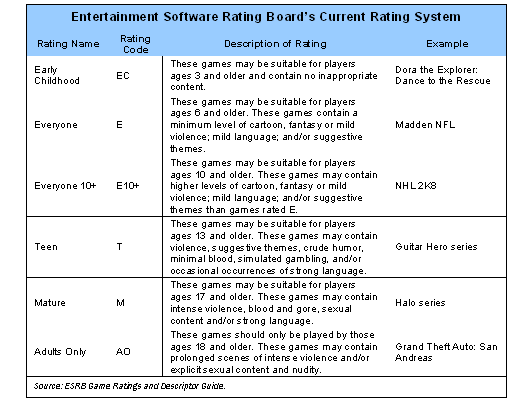
While the average game rating for the survey is age-appropriate and the “average game rating per respondent” mean is also fairly low, there are many teens in our survey who report playing games that are rated for much older players. Also, since many teens play unrated games, there is a whole portion of their gaming experience that we are missing.
Nearly one-third of young teens play M- or AO-rated games.
Almost one-third (32%) of all the teens in our survey play at least one game rated M or AO. Of these M- and AO-rated game players, 79% are boys and 21% are girls. Furthermore, 12- to 14-year-olds are equally likely to play M- or AO-rated games as their 15- to 17-year-old counterparts. Nearly three in ten (28%) of 12- to 14-year-olds list an M- or AO-rated game as a favorite, as do 36% of teens ages 15-17.53 For a small number of teens, all three of the games they mentioned had a version with an M or an AO rating; for others, only one of the games they offered as their top three current favorites was an M- or AO-rated game.
